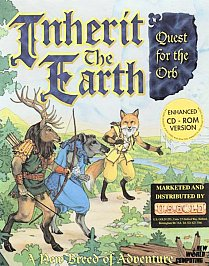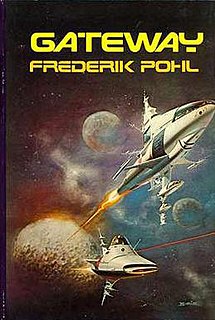The Heechee Saga, also known as the Gateway series, is a series of science fiction novels and short stories by Frederik Pohl. The Heechee are an advanced alien race that visited the Solar System hundreds of millennia ago and then mysteriously disappeared. They left behind bases containing artifacts, including working starships, which are discovered and exploited by humanity.
A sleeper ship is a hypothetical type of crewed spacecraft, or starship in which most or all of the crew spend the journey in some form of hibernation or suspended animation. The only known technology that allows long-term suspended animation of humans is the freezing of early-stage human embryos through embryo cryopreservation, which is behind the concept of embryo space colonization.

Doom II, also known as Doom II: Hell on Earth, is a first-person shooter game by id Software. It was released for MS-DOS computers in 1994 and Macintosh computers in 1995. Unlike the original Doom, which was initially only available through shareware and mail order, Doom II was sold in stores.

Carl Sanford Joslyn "Sandy" Petersen is an American game designer. He worked at Chaosium, contributing to the development of RuneQuest and later creating the acclaimed and influential horror role-playing game Call of Cthulhu. He would later join id Software where he would work on the development of the Doom franchise and Quake.

Frederik Pohl's Gateway is a 1992 interactive fiction video game released by Legend Entertainment, and written by Glen Dahlgren and Mike Verdu. It is based on Frederik Pohl's Heechee universe. It was followed by a sequel Gateway II: Homeworld, in 1993.

Inherit the Earth: Quest for the Orb is an adventure game developed by The Dreamers Guild and published by New World Computing in 1994.

Might and Magic V: Darkside of Xeen is a science fantasy role-playing video game published and developed for multiple platforms by New World Computing in 1993. Based on the Might and Magic III: Isles of Terra game engine, it is the fifth game in the Might and Magic series, and is a direct sequel to Might and Magic IV: Clouds of Xeen, concluding the story arc started in the original Might and Magic Book One: The Secret of the Inner Sanctum.

Dark Sun: Shattered Lands is a turn-based role-playing video game that takes place in the Dungeons and Dragons' campaign setting of Dark Sun. It was developed and published by Strategic Simulations in 1993. It received positive reviews although released initially in an unfinished state. The game had a sequel, Dark Sun: Wake of the Ravager, in 1994. An online MMORPG taking place in the same setting, Dark Sun Online: Crimson Sands, was released in 1996 and hosted on the T.E.N. Network.

Lufia & the Fortress of Doom, known as Estpolis Denki in Japan, is a role-playing video game developed by Neverland and published by Taito in 1993, for the Super Nintendo Entertainment System. It is the first title in the Lufia series of video games and the only game from the series released under the Taito label in North America.

Gateway is a 1977 science-fiction novel by American writer Frederik Pohl. It is the opening novel in the Heechee saga, with four sequels that followed. Gateway won the 1978 Hugo Award for Best Novel, the 1978 Locus Award for Best Novel, the 1977 Nebula Award for Best Novel, and the 1978 John W. Campbell Memorial Award for Best Science Fiction Novel. The novel was adapted into a computer game in 1992.

Haegemonia: Legions of Iron, or Hegemonia: Legions of Iron, is a 3D real-time strategy game developed by Digital Reality for Microsoft Windows, and by Microïds for iOS.
The planetary systems of stars other than the Sun and the Solar System are a staple element in many works of the science fiction genre.
Blizzard Entertainment's real-time strategy game series StarCraft revolves around interstellar affairs in a distant sector of the galaxy, with three species and multiple factions all vying for supremacy in the sector. The playable species of StarCraft include the Terrans, humans exiled from Earth who excel at adapting to any situation; the Zerg, a race of insectoid aliens obsessed with assimilating other races in pursuit of genetic perfection; and the Protoss, a technologically advanced humanoid species with psionic abilities that attempts to preserve their civilization and strict philosophical way of living from the Zerg. Each of these races is the focus of a series of missions in the single-player campaign of each StarCraft real-time strategy game. In addition to these three, various non-playable races have also been part of the lore of the StarCraft series; the most notable of these is the Xel'Naga, an ancient god-like race which features prominently in the fictional histories of the Protoss and Zerg.

Questron II a 1988 role-playing video game published by Strategic Simulations for the Apple II, Apple IIGS, Atari ST, Commodore 64, IBM PC, and Amiga. It is the sequel to 1984's Questron. Questron II is credited to Westwood Associates in the instruction booklet for the IBM PC version.

Ancient astronauts have been addressed frequently in science fiction and horror fiction. Occurrences in the genres include:

Assassin's Creed is an open-world action-adventure stealth video game franchise published by Ubisoft and developed mainly by its studio Ubisoft Montreal using the game engine Anvil and its more advanced derivatives. Created by Patrice Désilets, Jade Raymond, and Corey May, the Assassin's Creed series depicts a fictional millennia-old struggle between the Assassins, who fight for peace and free will, and the Templars, who desire peace through order and control. The series features historical fiction, science fiction and fictional characters intertwined with real-world historical events and figures. In most games, players control a historical Assassin while also playing as an Assassin Initiate or someone caught in the Assassin-Templar conflict in the present-day framing story. Considered a spiritual successor to the Prince of Persia series, Assassin's Creed took inspiration from the novel Alamut by the Slovenian writer Vladimir Bartol, based on the historical Hashashin sect of the medieval Middle East.

Mobile Suit Gundam 00 the Movie: A wakening of the Trailblazer is a 2010 Japanese anime science fiction film part of the Gundam metaseries and directed by Seiji Mizushima. The film is set two years after the second season of Mobile Suit Gundam 00, as the film sees Celestial Being against a group of hostile aliens known as ELS. The film is notable for being the first entry in Gundam to feature aliens as its antagonists. The film premiered on September 18, 2010, and was released on Blu-ray & DVD in Japan on December 25, 2010.

Beyond the Blue Event Horizon is a science fiction novel by the American writer Frederik Pohl, a sequel to his 1977 novel Gateway and the second book in the Heechee series. It was a finalist for two major annual awards, the 1981 Hugo Award for Best Novel and the 1980 Nebula Award. In the 1981 poll of Locus readers it finished second to The Snow Queen by Joan Vinge.
The Expanse is a series of science fiction novels by James S. A. Corey, the joint pen name of authors Daniel Abraham and Ty Franck. The first novel, Leviathan Wakes, was nominated for the Hugo Award for Best Novel in 2012. The complete series was nominated for the Hugo Award for Best Series in 2017. It later won, following its second nomination for the same award in 2020.
Michael Verdu is an American manager and producer and author of computer games.














